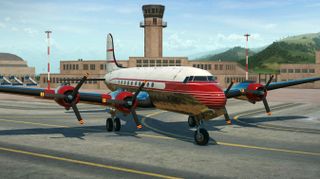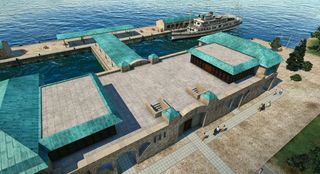Urban Games on why Transport Fever is more ambitious than its train-powered forerunner
A conversation about the "next generation transport simulation game."

Released in 2014, Train Fever was Urban Games' debut venture—a transport simulation game that echoed the likes of Transport Tycoon and Cities in Motion. It quickly accrued a fervent and dedicated fanbase post-release, however its at times overly-complex systems and monotonous spreadsheet-inspired interface were considered off-putting by many newcomers.
With Transport Fever—Urban's latest bite at the transport simulation cherry—the Swiss outfit has put its ear to the street, gathered feedback, and hopes to realise a grander, more sophisticated and, crucially, more accessible game. While its forerunner's sole focus was trains and trucks, Transport Fever adds planes, boats, trams and multiple public transport networks by land sea and sky.
I spoke with Urban's product and community manager Tom Schrettl about the scope of the studio's latest game, how it hopes to improve on the foundations laid by its predecessor, and how one goes about researching a game so deep and complex in stature.
Tom Schrettl is Urban Games' product and community manager who came on board after the release of the studio's last game Train Fever. He's also in charge of Transport Fever's campaign mode—14 missions split evenly across Europe and the USA which range from as far back as 1850, up to the present day.
PC Gamer: Train Fever is a deep and sophisticated simulation game, but how do you approach something like Transport fever which expands on pretty much everything in terms of scope and size?
Tom Schrettl: In our case it's that the first game—Train Fever—was quite successful and we have a very big and dedicated community, so we still have a lot of active players and we still get a lot of feedback for Train Fever. We learned a lot of what people liked, what they disliked, what they missed, so it was quite easy for us to figure out what we had to do improve or where we had to expand.
Of course we had our own ideas and Train Fever left some wishes open—tried to bring everything into the game which Train Fever was missing and this time we tried to communicate our plans and our progress. We've had weekly developer blogs where we show gameplay and collect feedback. We're currently in beta too with about 300 hundred players which we invited to test the game, so far that's been great too, having a dedicated fanbase is very valuable.
Was making something like Transport Fever - something much larger in scope than Train Fever - something you guys have always wanted to do?
PC Gamer Newsletter
Sign up to get the best content of the week, and great gaming deals, as picked by the editors.
I've not been with the company for as long as others—I've been here for a year or so—but I of course know the company's history. The founders of the company were very big fans of games like Transport Tycoon and Railroad Tycoon, and it was always their dream to make a modern version of those games. Train Fever was the first approach to that and I think it was very close but resources were limited. There were only three or four people developing the game and time was also limited. Luckily it was successful and now with more time, people and resources I think they can now do what they originally wanted to do.
Everything is meticulous—from vast and complex travel networks, to aeroplane landing gear animations—how do you go about researching something so involved?
Luckily enough we have very dedicated people in the company that are experts in certain things. We have a guy who is experts on planes, for example, another who specialises in trains, and another who's trained in economics. That helped a lot and as I said before we tied to talk about the game as early possible and show people what we do. The moment you share the latest screenshot of a plane that you're putting into the game - if something isn't right people will immediately point it out.

Is that always helpful, that you have such a dedicated and passionate fanbase?
Yeah, in our case I would say it is. The fans are also very understanding and often realise not everything is possible—that it's still a game. That was one thing I was afraid of when we started sharing information about the game, that people will not be satisfied about the game, that we'd miss something.
Airports, for example, are reduced in size in the game, they're not like two or three kilometres in length, but, say, four or five hundred metres, and and I think that people understand we can't always make it hyper realistic. We have to scale it down to make a game out of it and, crucially, make it fun. People also want to play, besides wanting a realistic simulation.
How important is modding to Transport Fever?
Very important. It started with Train Fever, where the guys decided to make it very modding friendly so that people could add their own content. When three or four guys work on a game you can only do so much and when you think about trains—there are so many different kinds from so many different areas from all over the world. People really like to have specialised trains from Eastern Europe or South America, or whatever, and people also like to add content of their own to the game.
Making the game open like this was a good decision. In Germany, the fanbase is up to 10,000 active people and they have a couple thousand mods for Train Fever. But people were still missing things they can't mod, so now you can mod cities—how they develop; you can mod how industries behave and you can add new industries to the game. You can even mod your own missions, such as campaigns.
How do you make sure this remains balanced—entertaining the existing community while welcoming newcomers at the same time?
The first thing we really had to do was add Steam Workshop support—that was really important. Without out it installing mods is difficult, even with fan pages you might need to config files etc., but now with Steam Workshop, as you know, it's just two or three clicks to add locomotives, industry chains, or even rebalancing the entire game as modders see fit. From the side of people using mods, it's very easy now. Creating mods, one thing we tried to do was make mods from Train Fever as compatible as possible so it's very easy to port mods from Train Fever to Transport Fever. Also, our missions, trains, campaigns, content is like modding content - it serves as an example of how to use the modding system.

One thing that particularly interested me in the video series have been the Ageing Process covered in the first blog—can you tell me more about that?
The vehicles are now much more detailed than in Train Fever and this ageing process is one of the new vehicle features. Every vehicle—locomotives, wagons, trucks, trams—has an overlay texture where we define in which places will gather dirt or rust over time. When the vehicle is in use, over a couple of years in the game, it gets more dirty or rusty. It's a really nice touch.
What will Campaign Mode involve?
We have two campaigns: one is located in Europe, and one in America. Each has seven missions, while the endless game lets you play from 1850 right through to today. The same goes for the campaigns—we try to set the missions so they're spread out over certain periods, and each mission has historical background. For example, the first mission in the USA is to build part of the transcontinental railroad, and the first mission in Europe is to build the Gotthard Tunnel - a famous tunnel which was made over 100 years ago.
Different to the endless mode, you have a lot of tasks to fulfil, so each mission has a final goal like, build this tunnel, or connect certain cities, however along the way you have sub-tasks where you have to deliver certain things to progress or meet certain criteria. You might even have to solve riddles, or make decisions which will later on affect the campaign. You can collect medals, ie optional missions, which are designed to make the game more difficult.
What's been the biggest challenge of moving from Train Fever to Transport Fever?
[Laughs] Do you mean me personally, or the company as a whole?
Both, let's start with you first.
I'm responsible for the campaign, so for me it was the big unknown processes development requires. I knew which tools I would have to work with eventually, but, before that, figuring out these grand stories and missions and goals and tasks, and putting everything together in your head before typing one line of code—that was my personal challenge. To come up with 14 missions ahead of time before you even start working on anything was difficult.
I think for the company it was scaling up. Having up to ten people instead of four working on a project, and making sure that everyone knows what they need to do and that everything runs smoothly—I think that was the biggest challenge overall.

You spoke before about balancing realism and making a fun game. With technological advancements what does the future hold for the simulation genre?
I'm not only a fan of our game, I play a lot of the genre itself. I see the biggest limitation at the moment is when you're required to simulate things on a grand scale. Take people, for example, in our game everyone has a home and workplace—if they go shopping they must decide which train line to take and so on—but there are limitations. At one point it will become unplayable. You can't have a million people in the game, and I think this is one of the main areas where simulations will expand in the future when they have more computing power on hand.
Soon enough you'll be able to really scale up and not only have cities with a thousand people, or a whole world with 100,000 people, but realistic scales in terms of inhabitants and also in landmass and size. Our maps in the new game are quite big—two, three hundred square kilometres and more—but it's not like the real world. I think the bigger the better and we'll see this in the future.
Train Fever launched in 2014, what support do you have planned for Transport Fever going forward?
For Train Fever we tried to support it as long as possible, so I think the last big patch was released this year in February or March. The same of course goes for Transport Fever—right after release we'll look at any possible problems, we'll look at the sort of content people are wishing for and we'll see what's useful. We want to expand the game also, be that free and/or paid content, and we want to improve and expand over the next few years if possible.
Speaking of release—have you pinned down a release date yet?
Transport Fever will launch on Steam November 8, 2016.
Most Popular

